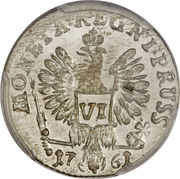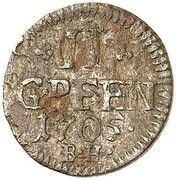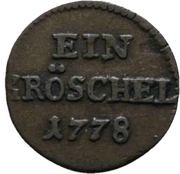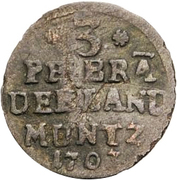Itens do Reino da Prússia
Você quer tirar uma foto com a câmera ou selecionar uma imagem existente?
(en) The Kingdom of Prussia (German: Königreich Preußen) was a German kingdom that constituted the state of Prussia between 1701 and 1918. It was the driving force behind the unification of Germany in 1871 and was the leading state of the German Empire until its dissolution in 1918. Although it took its name from the region called Prussia, it was based in the Margraviate of Brandenburg, where its capital was Berlin. The kings of Prussia were from the House of Hohenzollern. Prussia was a great power from the time it became a kingdom, through its predecessor, Brandenburg-Prussia, which became a military power under Frederick William, known as "The Great Elector". Prussia continued its rise to power under the guidance of Frederick II, more commonly known as Frederick the Great, who was the third son of Frederick William I.[8] Frederick the Great was instrumental in starting the Seven Years' War, holding his own against Austria, Russia, France and Sweden and establishing Prussia's role in the German states, as well as establishing the country as a European great power. After the might of Prussia was revealed it was considered as a major power among the German states. Throughout the next hundred years Prussia went on to win many battles, and many wars. Because of its power, Prussia continuously tried to unify all the German states (excluding the German cantons in Switzerland) under its rule, and whether Austria would be included in such a unified German domain was an ongoing question. After the Napoleonic Wars led to the creation of the German Confederation, the issue of unifying the German states caused a number of revolutions throughout the German states, with all states wanting to have their own constitution. Attempts to create a federation remained unsuccessful and the German Confederation collapsed in 1866 when war ensued between its two most powerful member states, Prussia and Austria. The North German Confederation, which lasted from 1867 to 1871, created a closer union between the Prussian-aligned states while Austria and most of Southern Germany remained independent. The North German Confederation was seen as more of an alliance of military strength in the aftermath of the Austro-Prussian War but many of its laws were later used in the German Empire. The German Empire lasted from 1871 to 1918 with the successful unification of all the German states under Prussian hegemony; this was due to the defeat of Napoleon III in the Franco-Prussian War of 1870–71. The war united all the German states against a common enemy, and with the victory came an overwhelming wave of nationalism which changed the opinions of some of those who had been against unification. In 1871, Germany unified into a single country, minus Austria and Switzerland, with Prussia the dominant power. Prussia is considered the legal predecessor of the unified German Reich (1871–1945) and as such a direct ancestor of today's Federal Republic of Germany. The formal abolition of Prussia, carried out on 25 February 1947 by the fiat of the Allied Control Council, referred to an alleged tradition of the kingdom as a bearer of militarism and reaction, and made way for the current setup of the German states. However, the Free State of Prussia (Freistaat Preußen), which followed the abolition of the Kingdom of Prussia in the aftermath of World War I, was a major democratic force in Weimar Germany until the nationalist coup of 1932 known as the Preußenschlag. The Kingdom left a significant cultural legacy, today notably promoted by the Prussian Cultural Heritage Foundation (Stiftung Preußischer Kulturbesitz (SPK)), which has become one of the largest cultural organisations in the world.
- Breslau, Prussian bishopric of
- Eastern Prussia, Russian occupation of
- Alemanha › Estados Germânicos › Prússia, Reino da
- Silesia, Province of
- South Prussia
- Württemberg-Oels, Duchy and Prussian rule of
Alemanha › Estados Germânicos › Prússia, Reino da › Breslau, Prussian bishopric of • Táler
1796
Moedas › Moedas circulantes comuns
Prata
KM# 231, Friedensburg# 2790, N# 319378
1753-1777
Moedas › Moedas circulantes comuns
Prata
KM# 225, Dav GT II# 2053, N# 277288
1748-1753
Moedas › Moedas circulantes comuns
Ouro 986‰ • 3,5 g
KM# 222, Fr# 530, Friedensburg# 2778, N# 365081
1796
Moedas › Moedas circulantes comuns
Ouro 986‰ • 3,5 g
KM# 232, Fr# 531, N# 277292
1748
Moedas › Moedas circulantes comuns
Ouro 986‰ • 17,5 g
KM# 223, Fr# 529, N# 277254
Alemanha › Estados Germânicos › Prússia, Reino da › Eastern Prussia, Russian occupation of • Thaler (1759-1762)
1 Thaler = 180 Groschen = 540 Schilling
1759-1761
Moedas › Moedas circulantes comuns
Bilhão (prata 62,5‰) • 0,53 g • ⌀ 15,1 mm
KM# 286, Bit# 785, Neum# 366, Diakov# 679, N# 120532
1759-1761
Moedas › Moedas circulantes comuns
Bilhão (prata 156‰) • 0,85 g • ⌀ 16 mm
KM# 287, C# 42, Schön DM# 36, Olding FR# 459, Schr# 1942, N# 120537
1759-1761
Moedas › Moedas circulantes comuns
Bilhão (prata 188‰) • 1,46 g • ⌀ 18 mm
KM# 288, C# 43, Schön DM# 37, Olding FR# 458, Schr# 1932, N# 63783
1759-1761
Moedas › Moedas circulantes comuns
Bilhão (prata 288‰) • 1,56 g • ⌀ 20 mm
KM# 289, C# 44a, Schön DM# 38, Olding FR# 456, Schr# 1915, N# 120538
1761
Moedas › Moedas circulantes comuns
Prata 500‰ • 4,36 g • ⌀ 24 mm
C# 47b, N# 120536
1759-1762
Moedas › Moedas circulantes comuns
Prata • 2,83 g • ⌀ 23 mm
KM# B290, C# 45, Schön DM# 39, Olding FR# 454, Schr# 1882, N# 63782
1761
Moedas › Moedas circulantes comuns
Prata 563‰ • 7,08 g • ⌀ 28 mm
C# 48, Bit# 806, N# 120535
1759-1761
Moedas › Moedas circulantes comuns
Prata 500‰ • 5,49 g • ⌀ 28 mm
C# 46, Bit# 675, Diakov# 628, Olding FR# 453, KM# C290, N# 120531
Alemanha › Estados Germânicos › Prússia, Reino da • Thaler
288 Pfennigs = 96 Gröschel = 72 Kreuzer = 36 Mariengroschen = 24 Groschen = 1 Thaler = ³⁄₁₇ Pistole • After 1857: 360 Pfennigs = 30 Silbergroschen = 1 Thaler
1703
Moedas › Moedas circulantes comuns
Bilhão (prata 125‰) • 0,3 g • ⌀ 13 mm
KM# 29, Schön DM# 3, Schr# 313, N# 127867
1703
Moedas › Moedas circulantes comuns
Bilhão (prata 125‰) • 0,3 g • ⌀ 13 mm
KM# 30, Schön DM# 3, Schr# 314-315, N# 127868
1705
Moedas › Moedas circulantes comuns
Bilhão (prata 62,5‰) • 0,59 g • ⌀ 12 mm
KM# 52, N# 310328
1735-1736
Moedas › Moedas circulantes comuns
Bilhão • 0,5 g • ⌀ 13,5 mm
KM# 217, Schön DM# 81, Schr# 419-422, Neum# 25, N# 127804
1741-1743
Moedas › Moedas circulantes comuns
Bilhão • 0,54 g • ⌀ 14 mm
Olding FR# 152, Kluge FrII# 204.2, KM# 227, Schr# 881, N# 89689
1746-1747
Moedas › Moedas circulantes comuns
Bilhão • 1,15 g • ⌀ 17 mm
Olding FR# 330, Kluge FrII# 317, KM# 927, Schön DM# 51, N# 55661
1751-1755
Moedas › Moedas circulantes comuns
Cobre • 2,55 g • ⌀ 21 mm
Olding FR# 157, 176, KM# 262, Schön DM# 102, Neum# 245, Schr# 911-916, N# 34547
1768-1770
Moedas › Moedas circulantes comuns
Bilhão • 0,6 g • ⌀ 14 mm
Olding FR# 153, KM# 319, Schön DM# 136, Schr# 883-6, N# 127805
1771-1786
Moedas › Moedas circulantes comuns
Bilhão (prata 94‰) • 0,6 g • ⌀ 14 mm
Olding FR# 154, KM# 326, Schön DM# 149, Neum# 514, Schr# 887-903, N# 25250
1787-1797
Moedas › Moedas circulantes comuns
Bilhão (prata 52‰) • 0,63 g • ⌀ 14,3 mm
KM# 350, Olding FR# 14, Schön DM# B158, Schr# 96-106, Neum# 9, N# 43811
1788-1789
Moedas › Moedas circulantes comuns
Cobre • 3,25 g • ⌀ 21 mm
KM# 353, Schön DM# A158, Olding FR# 15, Schr# 107-108, J# 1, N# 40408
1790-1797
Moedas › Moedas circulantes comuns
Cobre • 2,45 g • ⌀ 21 mm
KM# 353a, Schön DM# A158, Olding FR# 15, Schr# 109-116, J# 1, N# 98639
1792-1796
Moedas › Moedas circulantes comuns
Bilhão • 0,20 g • ⌀ 11,8 mm
Old/Mue 1# 39; 43, Jaeg 9 Pr# 201, KM# 5, Schön DM# 149, Slg. Wilm# 1152, N# 294114
1796-1797
Moedas › Moedas circulantes comuns
Bilhão (prata 111‰) • 0,26 g • ⌀ 9 mm
Old/Mue 1# 44, Jaeg 9 Pr# 202, KM# 12, N# 183124
1799-1803
Moedas › Moedas circulantes comuns
Bilhão (prata 111‰) • 0,26 g • ⌀ 14,5 mm
AKS# 148, Old/Mue 2# 164, Jaeg 9 Pr# 202, KM# 17, Schön DM# 155, Slg. Wilm# 1156, N# 161323
1799-1806
Moedas › Moedas circulantes comuns
Bilhão (prata 52‰) • 0,63 g • ⌀ 15 mm
AKS# 39, Old/Mue 2# 129, Jaeg 9 Pr# 2, KM# 373, Schr# 85, N# 42974
1799-1806
Moedas › Moedas circulantes comuns
Cobre • 2,45 g • ⌀ 20 mm
Old/Mue 2# 132, Jaeg 9 Pr# 1, KM# 372, Schr# 101, N# 130382
1804
Moedas › Ensaios
Ouro 986‰ • 0,91 g
Schlum# 654.1, KM# PnG13, N# 271081
1810-1816
Moedas › Moedas circulantes comuns
Cobre • 1,62 g • ⌀ 19,09 mm
AKS# 40, Old/Mue 2# 133, KM# 390, Kahnt/Schön# 1, N# 68014
1753-1755
Moedas › Moedas circulantes comuns
Cobre • 2,1 g • ⌀ 23 mm
KM# 55, N# 38407
1788-1797
Moedas › Moedas circulantes comuns
Cobre • 3,8 g • ⌀ 22,6 mm
Old/Mue 1# 20, KM# 1053, Schön DM# 80, Neum# 31, Schr# 160-165, N# 139444
1806
Moedas › Moedas circulantes comuns
Cobre • ⌀ 21 mm
AKS# 51, Jaeg 9 Pr# 9, KM# 1062, N# 60085
1811
Moedas › Moedas circulantes comuns
Cobre • 2,6 g • ⌀ 21 mm
AKS# 43, Jaeg 9 Pr# 19, KM# A393, Schr# 255, N# 85416
1703
Moedas › Moedas circulantes comuns
Bilhão (prata 125‰) • 0,44 g • ⌀ 13 mm
KM# 31, N# 310322
1703
Moedas › Moedas circulantes comuns
Bilhão (prata 125‰) • 0,22 g • ⌀ 15 mm
Olding FR# 58, KM# 32, N# 436241
1705-1706
Moedas › Moedas circulantes comuns
Bilhão (prata 125‰) • 0,68 g • ⌀ 13 mm
KM# 53, N# 310327
1788
Moedas › Ensaios
Ouro 900‰ • 5,59 g • ⌀ 21,7 mm
N# 313392
1810-1816
Moedas › Moedas circulantes comuns
Cobre • 3,24 g • ⌀ 21,8 mm
AKS# 38, Old/Mue 2# 131, KM# 391, Neum# 22, Schr# 247-249, N# 76653
1769
Moedas › Moedas circulantes comuns
Bilhão • 0,69 g
Olding FR# 326, Kluge FrII# 314.1, KM# 1014, N# 315443
1769-1770
Moedas › Moedas circulantes comuns
Bilhão • 0,61 g
Olding FR# 327, Kluge FrII# 314.2, KM# 1014a, N# 315444
1771-1786
Moedas › Moedas circulantes comuns
Bilhão • 0,49 g • ⌀ 14,5 mm
Olding FR# 328, KM# 1014b, N# 196982
1787-1797
Moedas › Moedas circulantes comuns
Bilhão • 0,45 g • ⌀ 15 mm
KM# 1050, C# 49, Schön DM# 81, N# 125286
1703-1705
Moedas › Moedas circulantes comuns
Bilhão (prata 125‰) • 0,59 g • ⌀ 16 mm
KM# 33, Schön DM# 5, Schr# 290-300, N# 124582
1703-1706
Moedas › Moedas circulantes comuns
Bilhão (prata 125‰) • 0,69 g • ⌀ 16 mm
KM# 34, Schön DM# 5, Schr# 301-305, N# 127871
Os revisores de Numista para as moedas deste emissor são escoins e silvergeek.
O revisor de Numista para a exonumia deste emissor é apuking.
Um item está ausente no catálogo? Adicione-o você mesmo! (em inglês)

































































































